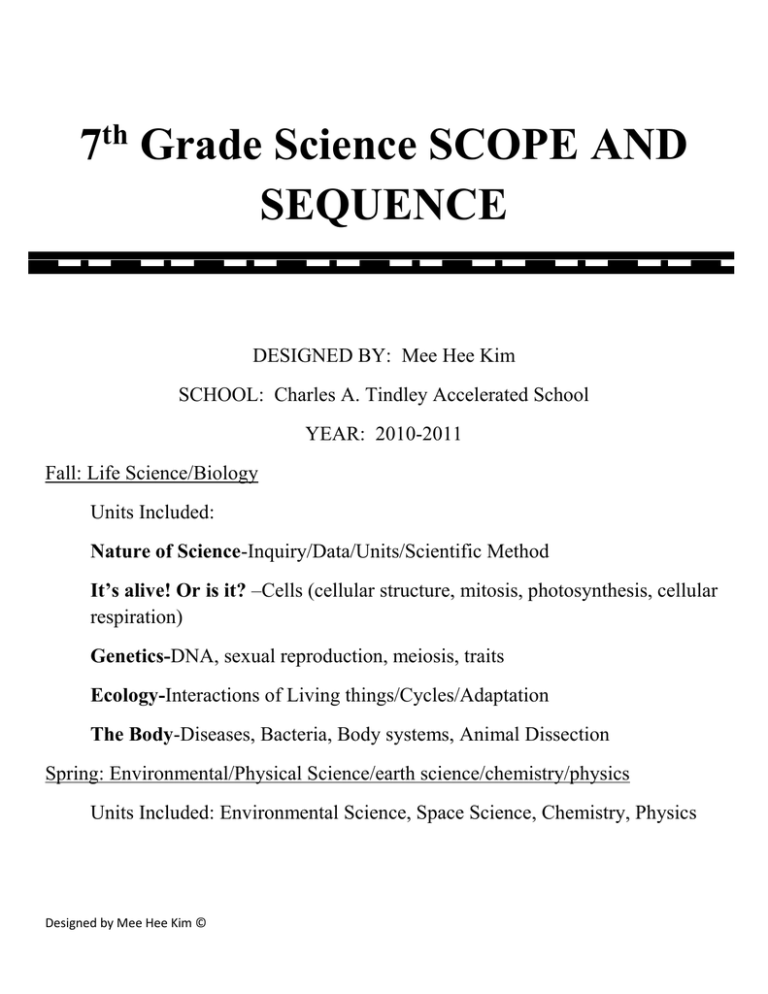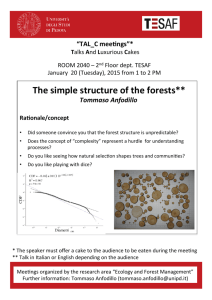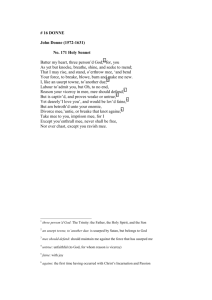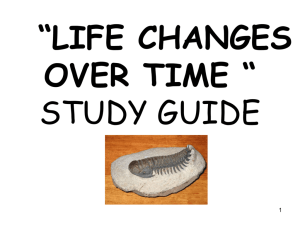7 th Grade Science SCOPE AND SEQUENCE
advertisement

7th Grade Science SCOPE AND SEQUENCE DESIGNED BY: Mee Hee Kim SCHOOL: Charles A. Tindley Accelerated School YEAR: 2010-2011 Fall: Life Science/Biology Units Included: Nature of Science-Inquiry/Data/Units/Scientific Method It’s alive! Or is it? –Cells (cellular structure, mitosis, photosynthesis, cellular respiration) Genetics-DNA, sexual reproduction, meiosis, traits Ecology-Interactions of Living things/Cycles/Adaptation The Body-Diseases, Bacteria, Body systems, Animal Dissection Spring: Environmental/Physical Science/earth science/chemistry/physics Units Included: Environmental Science, Space Science, Chemistry, Physics Designed by Mee Hee Kim © August 20-September 3rd Content/Theme Resources Nature of Science: Inquiry/Data/Units/Scientific Method o o o o Observation Station labs Science tool Identification lab Milk Lab Previous LL Standard/Benchmarks Current IAS( 2009): 7.1.1 Recognize and explain that when similar investigations give different results, the scientific challenge is to judge whether the differences are trivial or significant, which often takes further studies to decide. 7.1.2 Explain that what people expect to observe often affects what they actually do observe and provide an example of a solution to this problem 7.1.3 Explain why it is important in science to keep honest, clear, and accurate records 7.1.4 Describe that different explanations can be given for the same evidence, and it is not always possible to tell which one is correct without further inquiry. 7.2.6 Read analog and digital meters on instruments used to make direct measurements of length, volume, weight, elapsed time, rates, or temperatures, and choose appropriate units. 7.2.7 Incorporate circle charts, bar and line graphs, diagrams, scatter plots, and symbols into writing, such as lab or research reports, to serve as evidence for claims and/or conclusions Process Standards (NEW) Essential Questions Designed by Mee Hee Kim © 1. Make predictions and develop testable questions based on research and prior knowledge. 2. Plan and carry out investigations as a class, in small groups or independently often over a period of several class lessons. 3. Collect quantitative data with appropriate tools or technologies and use appropriate units to label numerical data. 4. Incorporate variables that can be changed, measured or controlled. 5. Use the principles of accuracy and precision when making measurement. 6. Test predictions with multiple trials 7. Keep accurate records in a notebook during investigations. 8. Analyze data, using appropriate mathematical manipulation as required, and use it to identify patterns and make inferences based on these patterns. 9. Evaluate possible causes for differing results (valid data). 10. Compare the results of an experiment with the prediction. 11. Communicate findings using graphs, charts, maps and models through oral and written reports. 1. What makes a good question? 2. How are scientific ideas formed and developed? Content Vocabulary 3. Why are units important in science? 4. How can you change the outcome of an experiment? 5. Why is it important to keep honest, clear, and accurate records? 6. What is the importance of work being reproducible? 7. Why must you keep a record of your work? 8. Why is math important in science? 9. How does looking at other data support the data that has already been? 10. How can a result disprove or prove a prediction? 11. How can a picture provide key information? Units Hypothesis/Claim Observation Data/Evidence Experiment Prediction Variables Quantitative Qualitative Triple beam balance Syringe Graduated cylinder Beaker Quantitative Assessments: Weekly math quiz Nature of Science Unit exam Scientific process quiz Design your experiment Qualitative Observation Station labs Measurement labs Science tool Identification lab Milk Lab Abilities Skills and Understandings o o o o o SWBAT… Identify questions and concepts that guide scientific investigations. Designing and conducting a scientific investigation. Use mathematics to improve investigations and communications/unit conversions Recognize and analyze alternative explanations and models Communicate and defend a scientific argument in writing and speech. Understandings o o o o o o Scientists inquire about how physical, living, or designed systems function. Scientists conduct investigations for a wide variety of reasons. Scientists rely on technology to enhance the gathering and manipulation of data. Mathematics is essential in scientific inquiry. Scientific explanations must adhere to accepted criteria. In communicating and defending results of scientific inquiry, arguments must be logical and demonstrate connections between natural phenomena, investigations, and the historical body of scientific knowledge. o All science tools have a specific function during laboratory use. o Science begins with a question and more information is found through questions. - September/October Content/Theme Resources It’s Alive! Or is it??- Cells (cellular structure, mitosis, photosynthesis, cellular respiration) Animal/Plant cell 3-D Model Previous Learning Ladders Core Standards Designed by Mee Hee Kim © Understand the cellular structure of living organisms, both single-celled and multicellular. (7) Describe features common to all cells that are essential for growth and survival, and explain their functions. (B) 7.3.1 Explain that all living organisms are composed of one or more cells and that the many functions needed to sustain life are carried out within such cells. 7.3.2 Understand that water is a major component within all cells and is required to carry out many cellular functions. B.2.2 Describe features common to all cells that are essential for growth and survival, and explain their functions. (partial) 7.3.3 Explain that although the way cells function is similar in all living organisms, multicellular organisms also have specialized cells whose specialized functions are directly related to their structure. 7.3.4 Compare and contrast similarities and differences between specialized subcellular components within plant and animal cells, including organelles and cell walls that perform essential functions and give a cell its shape and structure. B.2.3 Explain that most cells contain mitochondria, the key sites of cellular respiration, where stored chemical energy is converted into useable energy for the cell and some cells, including many plant cells, contain chloroplasts, the key sites of photosynthesis, where the energy of light is captured for use in chemical work. (partial) 7.3.5 Explain that cells in multicellular organisms repeatedly divide to make more cells for growth and repair. 7.3.7 Describe how various organs and tissues serve the needs of cells for nutrient and oxygen delivery and waste removal. 7.3.1: Why are we living? 7.3.1: What is a cell? 7.3.2: Why is water so important? B.2.2: How do cells function? 7.3.3: How does structure affect function? 7.3.4: What is the difference between plants and animals? B.2.3: Where does energy come from? 7.3.5: How does our body repair from injury? 7.3.6: How does an organ form? 7.3.7: How does our body maintain homeostasis? Prokaryotic Lysosome Fermentation Eukaryotic Golgi Cellular Respiration Cell wall Vacuole Organelle Ribosome Tissues Plasma membrane Organs Fluid mosaic model Nucleus Passive transport nucleolus Active transport Endoplasmic reticulum Diffusion Mitochondria Photosynthesis Quantitative Qualitative Weekly quizzes (Friday) Animal/Plant cell 3-D model Cell Parts Test Animal and Plant Cell Drawings Cell Function Test Meiosis microscope lab Unit Standards Essential Questions Content Vocabulary Assessments: Skills and Designed by Mee Hee Kim © - 7.3.1a: Explain major parts of the cell and their function - Understandings SWBAT… - 7.3.1b: Compare and contract eukaryotic cells and prokaryotic cells. 7.3.2a: Explain why organisms need food, water, air, and living space to survive. B.2.2: Compare and contrast eukaryotic and prokaryotic cells. 7.3.3: Discuss that form and function are directly related in a cell. 7.3.4a: Compare and contrast a plant and animal cell 7.3.4b: State the importance of a cell wall and how it relates to a cell’s function using osmosis, diffusion, active or passive transport 7.3.4c: Explain what endocytosis and exocytosis is and its importance. 7.3.4d: Describe how the cell wall functions to defend itself from harmful pathogens B.2.3: Describe that phtotosynthesis and cellular respiration are cyclic processes of transferring energy. 7.3.5 Explain the process of mitosis. 7.3.6: Discuss the sequence of life starting at the cell and forming body systems. 7.3.7: Explain the importance of metabolism and homeostasis Late October-Early November Content/Theme Genetics DNA, sexual reproduction, meiosis, traits Resources Biology: the dynamics of life Ch. 12 Inheritance WS Standard/Benchmarks Current IAS: (8) Understand the predictability of characteristics being passed from parents Core to offspring Standards Unit Standards (8) Explain how a particular environment selects for traits that increase the likelihood of survival and reproduction by individuals bearing those traits (B) Explain how genetic information from parents determines the unique characteristics of their offspring 8.3.3 Explain that genetic information is transmitted from parents to offspring mostly by chromosomes 8.3.5 Identify and describe the difference between inherited traits and physical and behavioral traits that are acquired or learned. B.5.1 Describe the relationship between chromosomes and DNA along with their basic structure and function. B.7.1 Distinguish between dominant and recessive alleles and determine the phenotype that would result from the different possible combinations of alleles in an offspring. B.7.3 Determine the likelihood of the appearance of a specific trait in an offspring given the genetic make-up of the parents. Prior Standards: n/a Essential Questions Content Vocabulary 8.3.2: Why do we look like our parents? 8.3.3: why do we look like our parents? 8.3.4: Why do we look like our parents? 8.3.5: why do we look like our parents? B.5.1: Why do we look like our parents? B.7.1: Why do we look like our parents? B.7.3 : Why do we look like our parents? Genes Genetics DNA Interphase Chromosomes Prophase Dominant Metaphase Recessive Anaphase Allele Telophase Traits Heredity Designed by Mee Hee Kim © Sexual reproduction Asexual reproduction Genotype Phenotype Offspring Meiosis Pedigree Homozygous Heterozygous Quantitative Assessments: Weekly quiz (Friday) Genetics exam Qualitative Microscope Meiosis Slide Lab Martian traits mini-lab Trait lab - complete a punnett square upon having genotypes - Differentiate genotype an phenotype - Diagram the process of meiosis and know that it is for sexual reproduction and only for sex cells - Determine how chromosomes determine sex - Interpret a pedigree - Analyze a pedigree - Explain why sex-linked disorders occur in one sex more often than in the other - Know that DNA is inside chromosomes and DNA is what causes people to have certain physical characteristics Skills and Understandings SWBAT… November Content/Theme Resources Ecology- Interactions of Living things/Cycles/Adaptation Previous learning ladders Explain how a particular environment selects for traits that increase Core the likelihood of survival and reproduction by individuals bearing Standards those traits. (8) Diagram how matter and energy cycle through an ecosystem. (B) 7.4.8 Describe how organisms that eat plants break down the plant Unit structures to produce the materials and energy that they need to Standards survive and in turn, how they are consumes by other organisms 7.4.9 Understand and explain that as any population of organism grows, it is held in check by one or more environmental factors. These factors could result in depletion of food or nesting sites and/or increased loss to increased numbers of predators or parasites. Give examples of some consequences of this. B.4.4 Describe how climate, the pattern of matter and energy flow, the birth and death of new organisms, and the interaction between those organisms contribute to the long term stability of an ecosystem. 8.3.8 Examine traits of individuals within a population of organisms that may give them an advantage in survival and reproduction in a given environments or when the environment changes. Essential Questions Content Vocabulary Predator Designed by Mee Hee Kim © Why has the human race continued to grow? What is survival of the fittest? Symbiosis Biotic Prey Ecology Ecosystem Biodiversity Adaptation Food chain Food web Mutualism Commensalism Parasitism Coevolution Consumer Producer Decomposer Scavenger Carrying capacity Quantitative Assessments: Abiotic Population Community Herbivore Omnivore Carnivore Qualitative Food chain diagram Unit exam “Finding nemo” quiz Analyze graphs and interpret data of carrying capacity Discuss the importance of the food chain and food web Understand the connection of all living things and non-living things must exist for all species to exist Diagram a food chain Explain what happens when one organism is suddenly depleted from a food chain Skills and Understandings SWBAT… November/December The Body-Disease, bacteria, virus, body systems, animal dissection o Fetal pig/frog dissection - Lab gloves, goggles dissection tray, dissecting kits, manuals o Sheep brain dissection o Digestive system ppt. o Circulatory system ppt. o Respiratory system ppt o Urogenital system ppt. Standard/Benchmarks Current IAS: AP 10 Identify and locate the organs of the cardiovascular system and discuss Core their functions. Standards Content/Theme Resources AP 12 Identify and locate major and accessory organs of the digestive system and discuss their functions AP 12 Analyze the digestive processes from ingestion to defecation AP 13 Identify and locate major organs of the respiratory system and discuss their functions AP 14 Identify and locate major organs of the urinary system and discuss their functions AP 15 Identify and locate major and accessory organs of the female and male reproductive systems and discuss their functions including oogenesis and spermatogenesis (partial) Unit Standards Designed by Mee Hee Kim © AP 10.2 Diagram the structure of a capillary bed and explain how materials move in and out of capillaries. AP 10.3 Describe the heart: include the pericardium, the layers in its wall, the four chambers, the valves, and the great vessels entering and leaving the heart. Describe the major arteries branching off from the aorta, and the regions they supply; describe the major veins entering the superior and inferior venae cavae. Explain with diagrams how the heart valves ensure one-way blood flow during systole and diastole. AP 12.1 Describe the functions of all the structural components and enzymes of the gastrointestinal tract and accessory organs in relation to the processing, digesting, and absorbing of the three major food classes. AP 13 Identify and locate major organs of the respiratory system and discuss their functions AP 14.5 Describe how the kidneys respond to excess water intake and to dehydration; explain the role of antidiuretic hormone and of other hormones that control sodium and water absorption in the kidney. Essential Questions Content Vocabulary Why do we need bacteria? What is a virus? What is a disease? Why is the body capable of doing so many things? o Why do we need to study animals to understand the human body? Mouth Kidneys Virus Esophagus Ovaries Host Larynx Scrotum Pathology Trachea Bronchia Binary fision Stomach Bronchioles Vaccine Spleen Alveoli Immunity Appendix Capillaries Frontal Liver Superior vena cava Posterior Gall bladder Inferior vena cava Anterior Bile Coronary artery Dorsal Small intestines Bladder Midsaggital Large intestines Ureter Lateral Rectum anus Urethra Decomposition Heart Testis pericardium Bacteria Quantitative Assessments: Weeklyfunctions quiz (Tuesday) Animal Dissection practical Dissection tools quiz Body systems exam Manipulate scientific equipment and tools for exposure of animal specimens Know the location and function of major body organs (respiratory, cardiovascular, urogential) Explain the interconnections of all body systems in the human body The relationship of blood and the capillary network Identify all anatomical structures within the hear including the major great vessels and the path of blood flow to the rest of the body Demonstrate with pictures and diagrams the flow or urine from the kidneys to the distribution of other substances before exiting the body Skills and Understandings SWBAT… January/February 2011 Content/Theme Qualitative Animal dissection lab Diseases brochure Earth and Space Science Designed by Mee Hee Kim © Resources Earth and Space Science o Holt Science Technology text ch. 2,3,4,5,9 Brain pop Standard/Benchmarks Current IAS: Describe how earth processes have shaped the topography of the Core earth and have made it possible to measure geological time. Standards Unit Standards 7.3.1 Recognize and describe that the sun is a medium-sized star located near the edge of a disk-shaped galaxy of stars and that the universe contains many billions of galaxies and each galaxy contains many billions of stars. 7.3.2 Recognize and describe that the sun is many thousands of times closer to Earth than any other star, allowing light from the sun to reach Earth in a few minutes. Note that this may be compared to time spans of longer than a year for all other stars. 7.2.1 Describe how the earth is a layered structure composed of lithospheric plates, a mantle and a dense core. 7.2.4 Explain how convection currents in the mantle cause lithospheric plates to move causing fast changes like earthquakes and volcanic eruptions, and slow changes like creation of mountains and formation of new ocean floor. 7.2.5 Describe the origin and physical properties of igneous, metamorphic and sedimentary rocks and how they are related through the rock cycle. 8.2.7 Recognize that some of Earth’s resources are finite and describe how recycling, reducing consumption and the development of alternatives can reduce the rate of their depletion. 8.2.8 Explain that human activities, beginning with the earliest herding and agricultural activities, have drastically changed the environment and have affected the capacity of the environment to support native species. Explain current efforts to reduce and eliminate these impacts and encourage sustainability. Essential Questions Content Vocabulary Prior Standards: o o What is a star? o What’s in space? o What is the sun made of? Rock cycle Rock Erosion Deposition Composition Designed by Mee Hee Kim © Strata Stratification Foliated Nonfoliated Natural resources Chemical energy Solar energy Wind power Hydroelectric energy Biomass Texture Intrusive igneous rock Extrusive igneous rock Renewable resource Nonrenewable resource Recycling Fossil fuels Petroleum Compression Tension Fault Deformation Plate tectonics Continental drift Sea floor spreading Crust Mantle Core Natural gas Coal Acid precipitation Nuclear energy gasohol Geothermal energy Spectrum Quantitative Assessments: Weekly quizzes Bill nye video questions Unit exam earth science Unit exam space science o o o o o o o o o o o o o o o o Skills and Understandings SWBAT… February/March 2011 Chemistry(See separate unit plan) Designed by Mee Hee Kim © Qualitative Sugar cube lab Hot or not lab Describe how the color of a star relates to the temperature Describe how scientists classify stars Describe the composition of the sun Explain that nuclear fusion is how the sun generates energy Interpret the H-R diagram Describe different types of stars Explain that stars are in different stages in their life Identify 3 types of galaxies Describe the big band theory Identify the layers of the earth and their physical properties Describe a tectonic plate Describe how the earth’s crust can become deformed Describe continental drift and how sea floor spreading moves continents Explain the 3 types of tectonic plate boundaries Describe how stress can deform rocks Describe the major types of fault and name several that have occurred within recent years o Content/Theme Apparent magnitude Absolute magnitude Light-year Parallax Nuclear fusion Sunspot Red giant white dwarf HR diagram Main sequence Supernova Neutron star Pulsar Black hole Galaxy Nebula Globular cluster Quasar Cosmology Big bang theory o Resources Standard/Benchmarks Current IAS: Core Standards Unit Standards Prior Standards: n/a Essential Questions Content Vocabulary Assessments: Quantitative Qualitative o Skills and Understandings SWBAT… April/May 2011 Physics Content/Theme Holt Technology ch 10, ch, 11 Resources Standard/Benchmarks Current IAS: Describe how atomic structure determines chemical properties and Core how atoms and molecules interact. Standards Core Standard icp Describe and explain the motion of macroscopic objects in terms of Newton’s laws and use the concepts of kinetic and potential energy to describe motion. Core Standard icp Describe how energy is produced and absorbed in chemical reactions. Unit Standards Designed by Mee Hee Kim © 8.1.2 Understand that elements are organized on the periodic table based on atomic number. 7.3.17 Investigate that an unbalanced force, acting on an object, changes its speed* or path of motion or both, and know that if the force always acts toward the same center as the object moves, the object’s path may curve into an orbit around the center. ICP.5.3 Understand that the atomic number is unique to each element and is the number of protons in the nucleus of the element. ICP.5.5 Using conservation principles write and balance chemical equations ICP.1.1 Measure the motion of objects to understand the relationships between distance, velocity, and acceleration and deepen understanding through graphical analysis of the time dependence of acceleration, velocity and distance. ICP.1.2 Describe and apply Newton’s three laws of motion. By experimentation, determine the relationships among the variables in Newton’s laws and how all three laws relate mass, acceleration and force as a triad of proportional variables, leading to the definitions of momentum and energy. ICP.1.3 Describe how Newton’s law of universal gravitation, together with the laws of motion, explains the motions of objects on earth and of the moon, planets and stars. Essential Questions Prior Standards: n/a What is physics? What is motion? What are newton’s laws? Content Vocabulary Gravity Speed Free fall Weight Assessments: Quantitative Weekly 3 quizzes Unit exam Designed by Mee Hee Kim © Force Newton’s 3 laws Projectile motion Acceleration Motion Netforce Inertia Newton Reference point Friction Momentum Terminal velocity Mass gravity Qualitative Speed lab Weekly brain pop review in class Skills and Understandings SWBAT… Designed by Mee Hee Kim © Match newton’s 3 laws with given examples Calculate speed, acceleration, time, momentum, force,and velocity Solve for unknown variables Identify proper units Interpret graphs showing speed, acceleration Understand the difference between weight and mass Apply skills from demos and apply the concepts of gravity into other examples o Identify the differences between kinetic and static friction and site examples o o o o o o o









